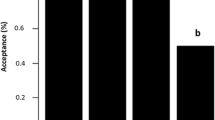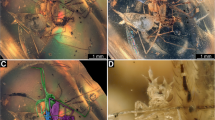Abstract
Larvae of Lomamyia spp. (Neuroptera: Berothidae) have been tentatively associated with several types of prey since they were first identified1. In all cases, the assumed prey lived in a confined habitat–an ant nest or termite gallery2. Lomamyia latipennis Carpenter has been the most thoroughly studied of these unusual Neuroptera. The immature states were described3,4 and the association with termites strengthened using Zootermopsis angusticollis Hagen (Isoptera: Kalotermitidae) as prey for a group of larvae4. A low survival rate of the larvae suggested that another termite might be the normal host. We now report field and laboratory findings which demonstrate the predator–prey relationship between L. latipennis and the subterranean termite Reticulitermes hesperus Banks (Isoptera: Rhinotermitidae) and describe their unique method of attacking prey with an aggressive allomone.
Similar content being viewed by others
References
Smith, R.C. Ann. ent. Soc. Am. 16, 129–151 (1923).
Gurney, A. B. Psyche 54, 145–169 (1947).
Tosch, C. A. Pan-Pacific Ent. 40, 21–26 (1964).
Tauber, C. A. & Tauber, M. J. Can. Ent. 100, 623–629 (1968).
Huber, I. Acarologia 20, 112–115 (1979).
Author information
Authors and Affiliations
Rights and permissions
About this article
Cite this article
Johnson, J., Hagen, K. A neuropterous larva uses an allomone to attack termites. Nature 289, 506–507 (1981). https://doi.org/10.1038/289506a0
Received:
Accepted:
Issue Date:
DOI: https://doi.org/10.1038/289506a0
- Springer Nature Limited
This article is cited by
-
Evolutionary relic or a curious coincidence? A mantisfly emerging from a mud-dauber nest
Evolutionary Ecology (2022)
-
Larvae of the Japanese termitophilous predator Isoscelipteron okamotonis (Neuroptera, Berothidae) use their mandibles and silk web to prey on termites
Insectes Sociaux (2014)
-
A mantispid larva can preserve its spider egg prey: evidence for an aggressive allomone
Oecologia (1983)





